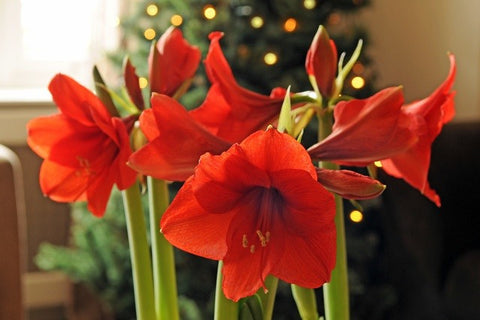Growing Guides: How to Grow Jumbo Amaryllis

Amaryllis throw large, striking blooms, held up proudly on tall, sturdy stems. One of the easiest bulb varieties to grow, these beauties quickly deliver a showy display. Amaryllis are loved for their beautiful, upright flowers.
How to plant jumbo amaryllis bulbs (indoors):
- Select containers that will be heavy enough to support the weight of the tall stems and large blooms as the amaryllis grows. Containers should weight at least several pounds when empty. Or, you can fill lighter containers with rocks, pebbles or sand to increase their weight. The diameter of the container should be only about 1-2 inches larger than the diameter of the bulb. They like to be snug! If planting several bulbs in a container, there's no need to leave space in between but plant them shoulder to shoulder next to each other.
- Fill your container with well-draining soil. Amaryllis bulbs will quickly rot if they are sitting in waterlogged soil.
- Plant the Amaryllis bulb with approximately an inch of the top of the bulb sticking out of the surface of the soil. In other words, do not cover the bulb completely with soil. You will need to see an inch long 'stem' sticking out of the top of the soil.
- After planting, water well so that the soil above the bulbs settles. Do not water again (or water very sparingly) until you see the first leaves emerge.
- Situate your container in a bright location, such as a windowsill, where the plant can get plenty of light.
- Amaryllis tend to lean towards the light, so as the flower stems begin to grow, rotate the container regularly so that the stems will grow straighter.
How to plant jumbo amaryllis bulbs (outdoors):
- In the Fall, choose a spot that is mostly sunny or has only partial shade and has fairly well-draining soil.
- Planting amaryllis bulbs is fairly simple. Bulbs look much like an onion, with wiry roots growing out of one site and a spike on the other. Plant with the roots pointing down and the spike pointing up.
- Plant the Amaryllis bulb with approximately an inch of the top of the bulb sticking out of the surface of the soil. In other words, do not cover the bulb completely with soil. You will need to see an inch long 'stem' sticking out of the top of the soil.
- Regarding the spacing between bulbs, if planting in beds, leave at least 3 inches between each bulb. If you are planting in containers, you can cluster them a little closer together.
- After planting, water well so that the soil above the bulbs settles. Do not water again (or water very sparingly) until you see the first leaves emerge.
- You can only plant Amaryllis bulbs outside in zone 9 or 10. If you have freezing temperatures during winter time, you can't plant amaryllis outside in your area. In the garden they bloom in March, April, or May, depending on the variety. Some may produce bloom spikes again in the fall. Keep the potted bulb in a warm and bright spot. Often, second or sometimes even third flower stalks will develop some time after the first flowering. Try to let the foliage alone and don't trim it off immediately as the leaves help the plant store energy for future growth. In warmer climates, leaves are evergreen and will be green and attractive year-round.
- During the summer, let the leaves soak up lots of warmth and sun. Water lightly and keep good drainage.
- The following fall, you will want to try to persuade your amaryllis bulbs to take a rest period before beginning a new flowering cycle. Lift the bulbs and bring the bulbs indoors, trim all foliage and store in a dry, dark location, without watering them, for up to 12 weeks. After 12 weeks, start again with step 1!
> Shop All Jumbo Amaryllis Bulbs